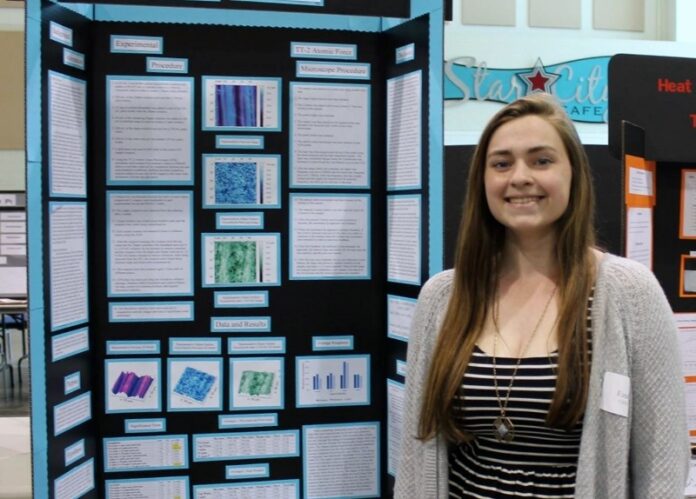
“There’s money in water,” is a phrase I’ve heard from the Cathey family for years, and for good reason. Between Emily and her brother, William, they have won over $1,500 in various science fairs’ special awards during high school, including notable awards like the Stockholm Junior Water Prize, the American Water Works Association Award, and the Virginia Lakes and Watershed Association Award. With water considered the world’s most valuable natural resource, it’s admirable to try to further our understanding of it, “but the money’s nice, too,” said Emily Cathey, laughing. “It’s a big motivator.”
Cathey, a current senior at Roanoke Valley Governor’s School for Science and Technology, went to her teacher mentor last spring for guidance about how to turn her latest water research idea into a project that would really stand out, and he came up with a way Cathey could work with water while also being one of the first students to explore the school’s new $40,000 atomic force microscope (AFM).
A signature piece of cutting-edge technology used in research at the nanoscale level – the prefix “nano” means “one-billionth” – the AFM works differently than traditional microscopes, which provide optical images from light passing through samples. The AFM instead generates digital 3D images of a sample by measuring the position of a probe as it passes across the sample’s surface. Each AFM image is a composite of tens of thousands of data points.
After talking with her mentor, Cathey decided on a project that would determine and compare the corrosive effects of different concentrations of chlorine on copper water pipes. In the process, she also tested the corrosiveness of Roanoke Valley tap water, the inhibitive effect of phosphate on chlorine-induced copper corrosion, and the sub-microscopic effects of copper corrosion. Here’s how she did it:
First Cathey used the AFM to scan new copper pipe samples several times for her “before” images. She then suspended the pipe samples for two weeks into one of four different solutions – tap water, distilled water with 4 parts per million of sodium hypochlorite (chlorine bleach), distilled water with 20ppm of sodium hypochlorite, or distilled water with 20ppm of sodium hypochlorite plus 0.2mg of sodium phosphate (a salt mixture). Then she scanned each sample several more times to produce her “after” images so that she could determine whatever corrosion had occurred.
Once Cathey charted those results, she acid-washed the samples to remove the corrosion, scanned each sample several more times to observe whatever damage the corrosion had caused, and then she charted those results. She analyzed her data and statistics with computer software, and here’s what she found:
“Using the AFM, I was able to show that higher concentrations of chlorine produce more corroded copper, and that phosphate is a very effective inhibitor of corrosion,” said Cathey. “I also found that the tap water in Roanoke contains low levels of chlorine – tap water produced the least corrosion to copper pipes of the four solutions I tested. We’re fortunate here in Roanoke – many communities have to worry about their water quality, but we can drink our water straight from the tap.”
In total, Cathey’s project won three special awards and four ribbons at science fairs this year – two blue, one red, and an Honorable Mention at the prestigious Virginia State Science and Engineering Fair on April 14 – and she’s not done yet. During her project she worked so closely with the Western Virginia Water Authority, one of the Governor’s School’s community partners, that they have requested a copy of her final paper at the end of the school year. “Plus I won $175,” Cathey said, smiling. Don’t forget about that!”
-Regina Carson


